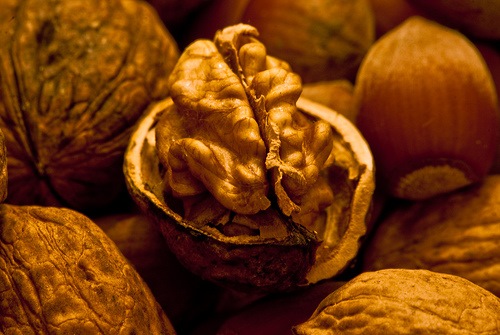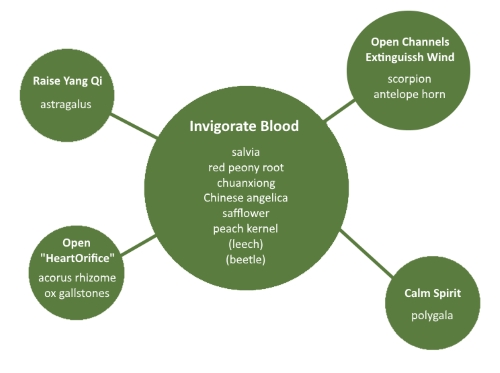
Image by La Belle Lumière (flickr/lepimento) under CC BY-NC-ND 2.0
Having treated both traumatic brain injury (TBI) and stroke using Chinese medicine, I was intrigued by a recent Forbes article on healthcare innovation. Though it wasn’t apparent from the headline, the article transcribed a discussion on a recent supplement used for neuroregeneration and neuroprotection. The supplement has mostly been studied for its effects in stroke rehabilitation, but it also bodes well for both TBI and Alzheimer’s patients.
The intriguing part is that this supplement, NeuroAiD, is developed from herbs commonly used in Chinese medicine. It is not only intriguing but also hints a little at intrigue [bonus trivia—a word where its verb and noun have vastly different meanings: intrigue, v., is to arouse interest; intrigue, n., is a deceitful stratagem].
Now I don’t aim to be melodramatic with talk of intrigue (n.), but I’ll explain shortly.
There are two versions of NeuroAiD, which is available in Asia and Europe. NeuroAiD I contains (9) Chinese herbs and (5) Chinese non-herbals (i.e. animal-product medicinals); NeuroAiD II contains the same Chinese herbs, but excludes the animal products.
So far, not much intrigue (n.). The exclusion of animal products makes sense. Here they are: leech, beetle/cockroach, ox gallstones, scorpion, antelope horn. These are excluded for European consumers, presumably based on the ew-factor (leech, beetle/cockroach, scorpion) and animal rights (ox gallstones, antelope horn). NeuroAiD II is also vegan-friendly.
Here are the (9) Chinese herbs: astragalus, salvia, red peony root, chuanxiong, Chinese angelica, safflower, peach kernel, polygala, acrous rhizome.
NeuroAiD is not available in the U.S. because it is not approved by the FDA. However, all of the herbs are very commonly used safely in United Stateside Chinese medicine practice. The animal products will be hard to find, but I’d bet they can be found in a few Asian apothecaries.
Here is where my imaginative mind conjures intrigue (n.)…
There is limited transparency, at least here in the U.S., regarding this most basic enquiry: is there any significant difference between NeuroAiD (banned in the U.S.) and a Chinese formula I can easily and legally build using the same exact herbs?
The more specific question is whether the NeuroAiD ingredients are plant-derived, semi-synthetic or synthetic; or powders or extracts of the whole herbs.
Moleac, based in Singapore, is the maker of NeuroAiD. When you search online for either Moleac or NeuroAiD, you can see excerpts from their sites. But when you click on them, and after getting a glimpse of their site, you are quickly redirected to a landing page saying that NeuroAiD is not marketed in the United States/Canada/China. Their sites are being blocked! What’s the big secret when the ingredients are so readily available here? Why censor them?
Eh, I was just having fun speculating. I easily pulled up the product packaging on a Filipino website. Granted, the packaging could be misleading since it isn’t FDA-approved. But it appears that the ingredients are either powdered or extracted whole herbs with no other ingredients added.
So whoever you censors are, I answered my question and I can proceed to utilize the formula using whole herbs.
Chinese Formula Analysis
NeuroAiD is marketed (in Asia and Europe) for ischemic stroke. This is a very important distinction. This formula is only appropriate for strokes that involve a blood clot or other obstruction to blood flow. It is NOT appropriate for strokes that involve a rupture in the blood vessels in the brain.
When you look at the herbs in the formula, the treatment principle is evident: invigorate blood, raise the yang qi (target the brain), calm the spirit, and open the “heart orifice” (normalize brain function).
When you consider the animal products, the treatment principle is to open the channels (target the limbs), invigorate blood, extinguish wind (stop tremors, relax spasms), and open the “heart orifice.”

Chinese medicine formula for ischemic stroke.
This formula is a modification of the classical Chinese formula, Bu Yang Huan Wu Tang, with the subtraction of earthworm; and the addition of salvia, acorus rhizome, polygala, leech, beetle, scorpion, antelope horn, and ox gallstones.
The combination of acorus rhizome and polygala treats slurred speech; scorpion treats facial paralysis; and beetle treats hemiplegia. (Bensky, 1990)
I don’t recommend looking for scorpion (Buthus martensii). It is useful but very toxic with a narrow margin of error in dosage. Leech is slightly toxic.
Interpretation of Astragalus
My interpretation of the use of astragalus deviates from the traditional notion that it is used here to tonify qi. The traditional interpretation harkens another classical formula, Bu Zhong Yi Qi Tang, that is used for qi deficiency that includes weakness of the limbs.
In Bu Zhong Yi Qi Tang, astragalus does tonify qi while also raising yang. But the condition for which that formula is appropriate is spleen and stomach deficiency. While ischemic stroke can result in atrophy and weakness of the limbs, the mechanism of the atrophy is neurological rather than metabolic (as seen in spleen and stomach deficiency).
Further, I deviate from the classic interpretation of “raising yang qi.” Of course there is no direct translation to English, but the general connotation is that astragalus has an uplifting quality—physically, e.g. treating prolapse; and mentally, e.g. lifting the spirits or clarifying thoughts. In this case, I view astragalus as a messenger herb, guiding the action of the blood invigorating herbs upward to its target: the brain.
Chinese Medicine Stroke Treatment Plan
A typical Chinese medicine stroke rehabilitation plan incorporates not only herbs but also acupuncture and tui na (massage). It is important to start therapy as soon as possible after hospital discharge. Waiting beyond six months (after discharge) before starting treatment can significantly reduce success rates.
Reference
Bensky, Dan and Randall Barolet. Chinese herbal medicine: formulas & strategies. Seattle, WA: Eastland Press, 1990. Print
Carl is a former engineer who applies rational thought to the often subjective nature of traditional healing. He practices acupuncture in San Diego, CA.
